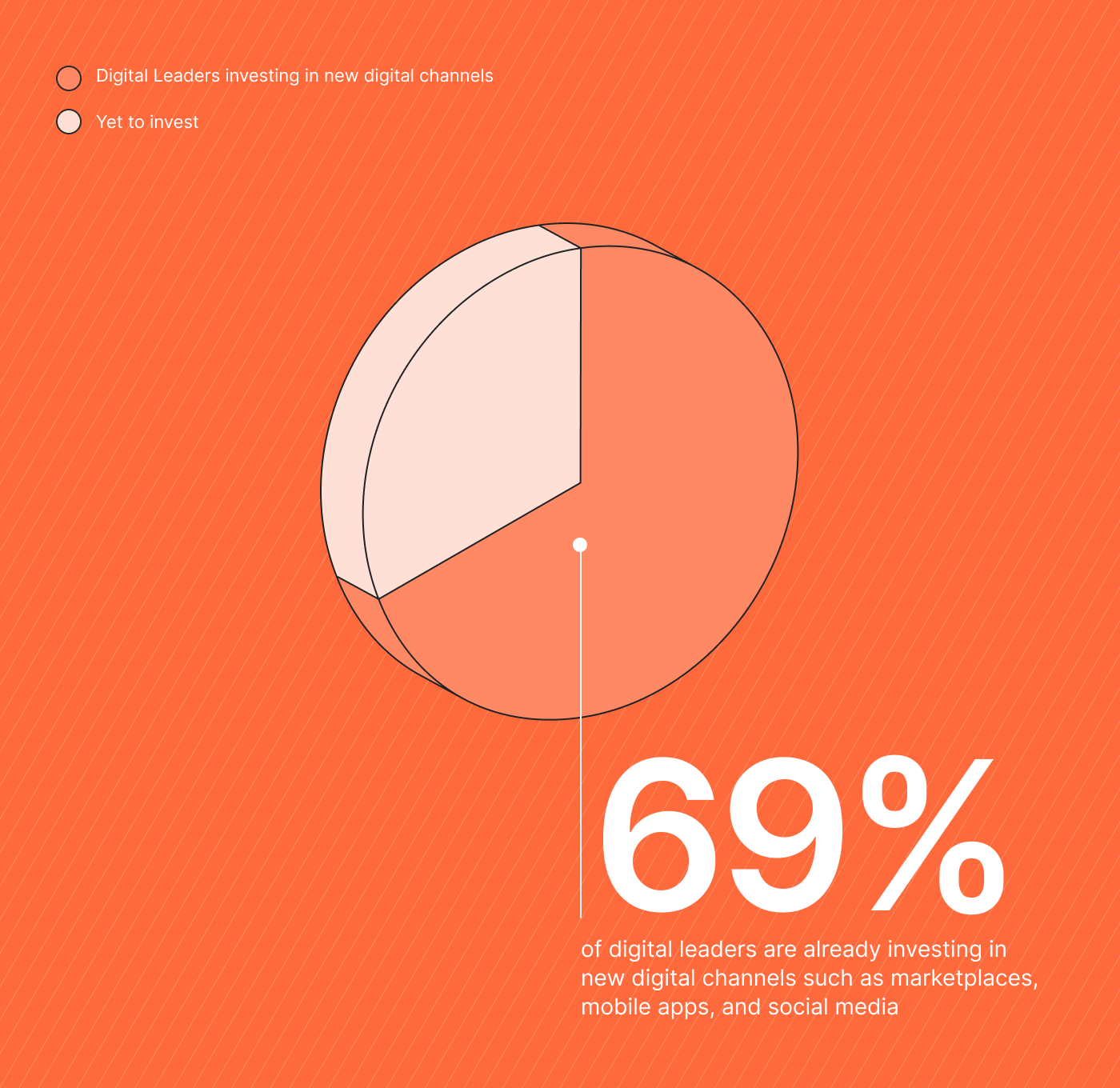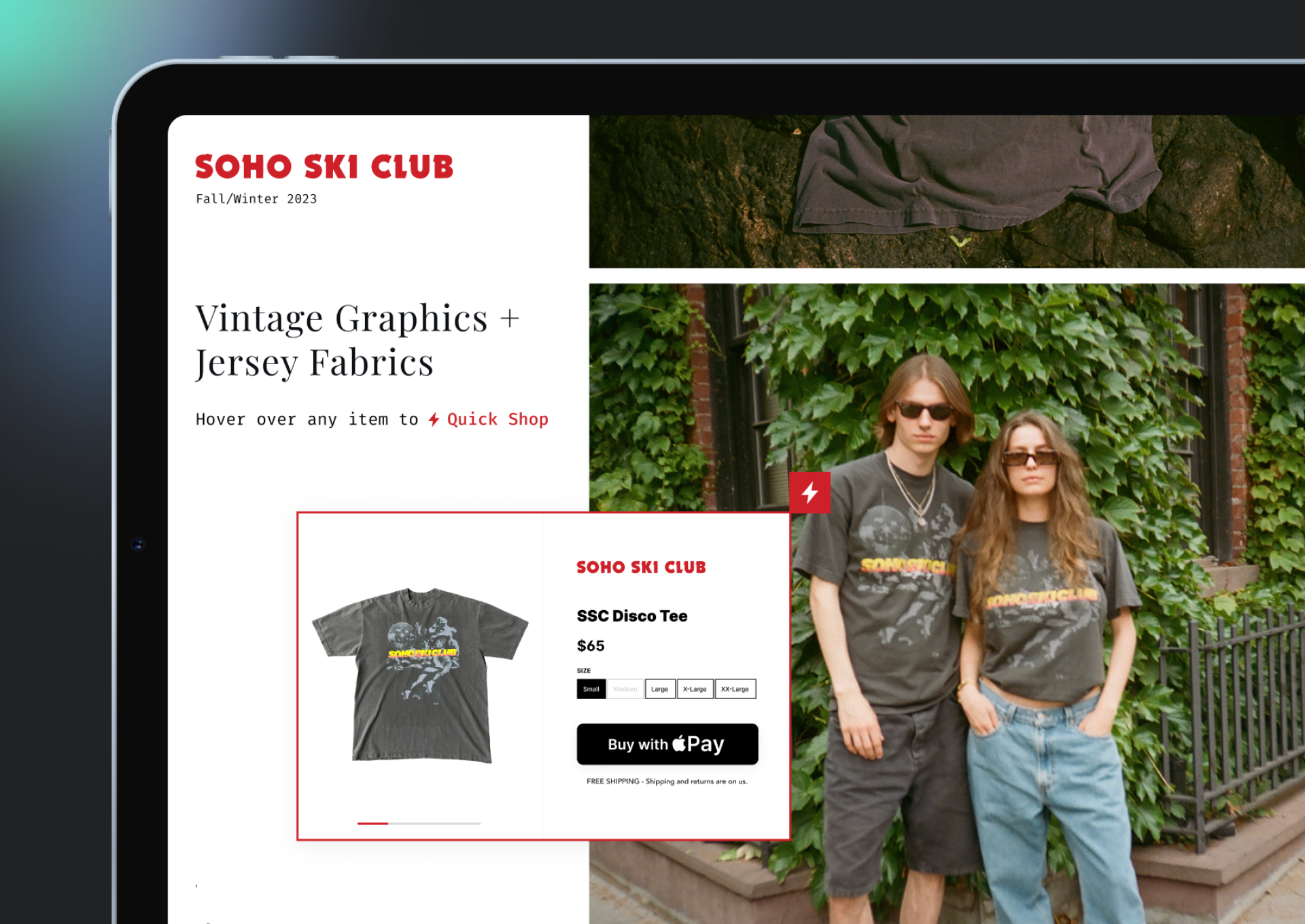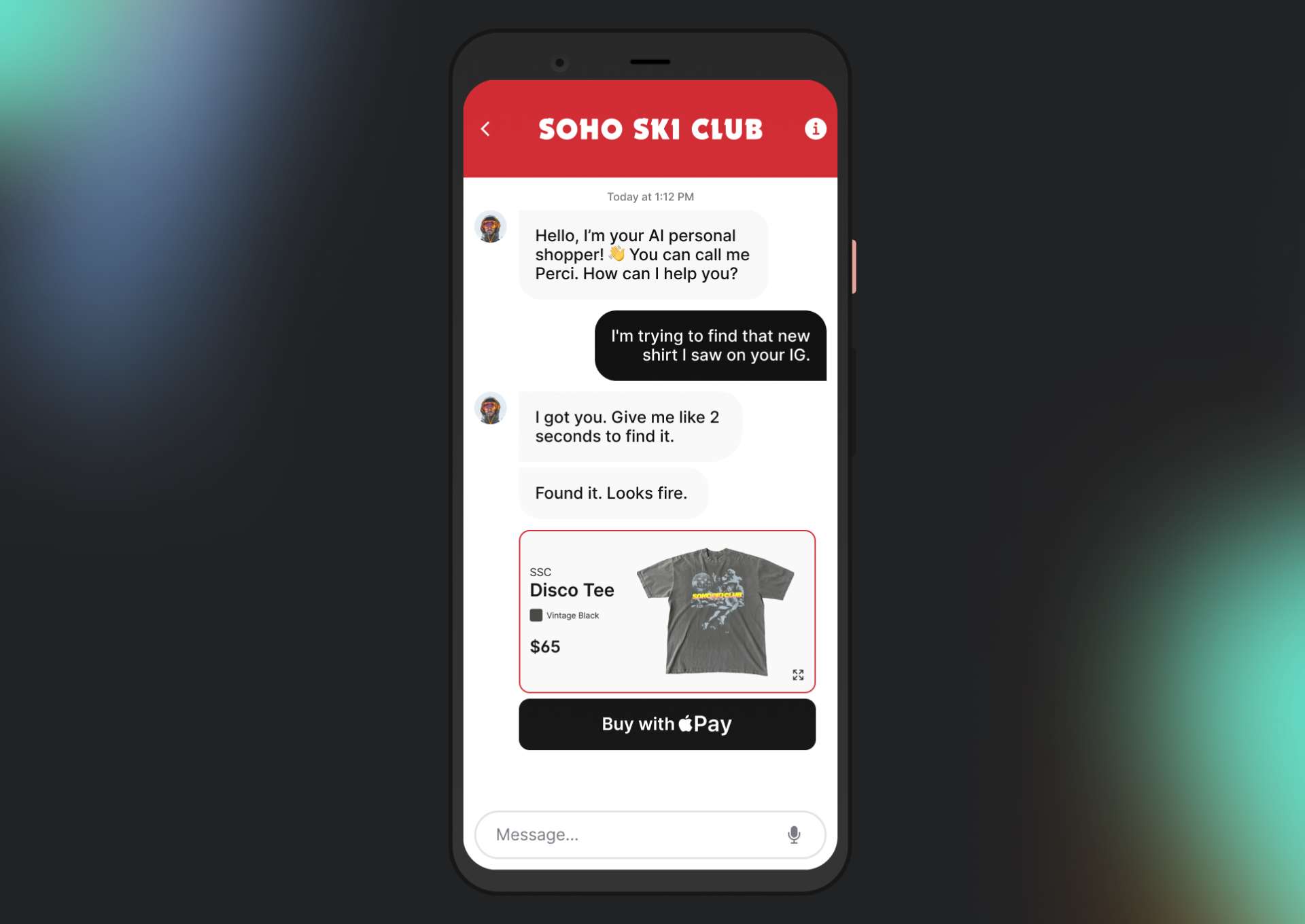
Distributed Commerce: Everything You Need to Know
SHARE:
Introduction
This guide is designed to support your sales strategy and leverage untapped channels via shoppable content and distributed commerce. If you’re drawing a blank right now, that’s OK—distributed commerce is still a new strategy in the world of e-commerce, but one that brands, merchants, marketing and sales teams have started implementing more in recent years.
We'll break down distributed commerce-isms like embedded checkout and shoppable content, then dive into a tour of different channels and their benefits.
By the time we’re done, you’ll understand how to implement distributed commerce to offer a smoother customer experience and broaden your sales reach.

CHAPTER 01
What is distributed commerce?
Retailers historically focused on sending customers to specific destinations to shop—whether brick-and-mortar stores, online websites, or both. And that was kind of it. Now, technology allows brands to meet consumers where they are online.
Distributed commerce acts as a checkout that's available wherever the customer needs it, whether that's while they're scrolling a website, on social media, playing a game, or watching TV.
Here are a few examples of distributed commerce:

01. Articles
A customer is reading a blog about the best cameras of 2024 and spots one they love: Without leaving the page, they can buy it through an embedded checkout—an overlay appears on the product that lets them confirm their details and complete their purchase.

02. Socials
An ad for a customer’s favorite artist's concert pops up in a social media app: they click the “Buy Now” button to get their tickets right there.

03. Gaming & VR
A customer spots a t-shirt they want in an online game. No need to mess around with converting currency; they can buy the physical shirt without leaving the game in just a few clicks. It ships to their door as if they’d bought it on an e-commerce site.
It doesn't matter where a shopper sees the product; with distributed commerce, they're able to buy it without leaving their chosen activity or the environment they're in.

The problem distributed commerce solves
It all comes down to removing friction and unnecessary barriers, which can affect online sales. Baymard Institute found, in multiple studies across a decade, that 70% of US retail shoppers have abandoned a purchase online. 25% of those shoppers said it was because they were asked to create an account.1 The Institute estimates that a $260 billion loss could have been avoided with a better checkout design and flow.2 They also calculated that a better checkout experience would lead to an improvement of 35% in large e-commerce store conversion rates.3
It makes sense; buying online isn’t always straightforward: there are cookies to be accepted, popups to be closed, newsletter signups, and offers of 10% off for first-time shoppers who create an account. That’s not accounting for the checkout pages, either. What’s your CVV again? Sometimes you’d rather just close the page than go through the checkout gauntlett.
It all adds up fast: It’s estimated that an awkward checkout experience is costing US retailers around $111–136 billion in revenue every year.4
This is where distributed commerce comes in. Let’s say you're reading an article about the best hiking trails, and there it is—an ad for the exact kind of hiking boots you’ve been wanting. Distributed commerce makes it so you don't need to open a new tab, go search for the product, get sent to the retailer’s site, or deal with a clunky checkout process.
You’d simply click "Buy Now" right there on the page. This triggers the embedded checkout and those boots are yours. Now back to reading about those hiking trails.
70%
70% of US retail shoppers have abandoned a purchase online
25%
25% of those shoppers said it was because they were asked to create an account.

CHAPTER 02
How distributed commerce helps
The digital shift in the retail sector, accelerated by the pandemic, made us all expect faster results. Customers want quick solutions, especially in checkout and shipping processes. (We’ve all groaned when we get an Amazon notification that something will take two days to arrive, instead of one.) Distributed commerce caters to this shift, allowing for seamless purchases without the need for multiple steps or site navigation. 6, 7, 8

All-mobile everything
Since over half of internet and e-commerce activity is on mobile, all retailers should be optimized for it.9 Yet, challenges like small screens and cumbersome input methods lead to almost 85% of carts being abandoned on mobile (compared with around 70% on desktop).10 Fortunately, it works the other way too—73% of global shoppers say that a good experience contributes to brand loyalty.11
Enter the "Buy Now" button. Let’s take a closer look at the hype.
According to Baymard Institute, which ran a 12-year analysis, the average global cart abandonment rate is 69.8%
"Buy Now" buttons in modern e-commerce
The "Buy Now" button has received a lot of attention in the e-commerce space in recent years, appearing on more sites. In the case of Amazon, however, it briefly vanished. In 2020, Amazon appeared to quietly conduct an A/B test by removing the "Buy Now" button, leaving only the "Add to Cart" option on product pages.12 While exact metrics weren't disclosed, the reinstatement of the "Buy Now" button, which now appears in addition to "Add to Cart," implies it had a positive impact on conversion rates.
This trend extends beyond Amazon, as evidenced by a PYMNTS survey involving over 800 prominent U.S. online retailers. They report "strong correlations between buy buttons and faster conversions".13 This makes sense, given that e-commerce checkouts using "Buy Now" buttons are 46% faster than traditional checkout methods.14,15
The reduction of friction and a faster checkout process suggest an increased likelihood of sales. The "Buy Now Button" is more widespread, too. Notably, 73% of all online merchants have adopted it,16 suggesting it’s anything but a flash in the pan.
When commerce and marketing converge
Customers often require multiple touchpoints before making a purchase, with RAIN Group noting an average of 8 interactions.17 Distributed commerce, through embedded checkouts or "Buy Now" buttons, allows timely purchases, keeping customers engaged without disruptions.
Marketers and retailers are all vying for the attention of consumers, who are often multitasking or flipping between several apps or platforms at once. Maybe they’re texting, listening to music, scrolling through social media, and playing a game on their morning train ride to work. In the "attention economy," where a customer’s focus is as good as gold, every moment, and every platform where they encounter content, counts.18

CHAPTER 03
How distributed commerce works
Let’s take a closer look at the technical side to see how distributed commerce can slot into your existing approach to sales and marketing.
Salesforce reports that 69% of digital leaders are investing in new digital sales channels like marketplaces and social media.19 While this is great for increasing market reach, it also demands larger teams and can be slow to adapt. In fact, 34% of these digital leaders experience lengthy implementation changes, taking weeks or even months.20


Headless commerce and the dynamics of integration
Transitioning to headless commerce, which separates the front and back end of your website, can help address these challenges. It allows for faster updates to product listings without affecting the website layout and can help make distributed commerce more accessible.
Tools like Dispatch’s e-commerce connectors allow you to effortlessly integrate into popular platforms such as Shopify, Adobe Commerce, and Salesforce B2C Commerce Cloud. And if there's a platform not currently supported, custom integrations can bridge that gap.
This lets customers order wherever they are via your embedded checkout or "Buy Now" button, with little change to your usual sales flow:
- Your existing payment provider stays the same.
- Your brand stays as the merchant of record.
- Your customer service, return, and finance workflows are unchanged.
It’s as if the order happened on your website.

CHAPTER 04
Leveraging ads in distributed commerce
Shoppable media has transformed online advertising, turning ads into direct points of purchase for consumers.
Ads are no longer passive; they‘ve become more like interactive gateways. Leveraging targeted content, shoppable ads integrate the shopping experience into the ad itself. This approach takes advantage of consumer interest at the moment of discovery, allowing them to move from interest to purchase without the need to leave the site they’re on.

Picture Sophie: She’s 28 and obsessed with fashion. Hours of her free time are spent scrolling online to find inspiration and pounce on the perfect item when she sees it.21 (We all know a Sophie.) Previously, an ad would redirect her through multiple steps on a retailer's site, creating friction. With shoppable media, she clicks "Buy Now" within the ad, ensuring a smooth checkout. McKinsey suggests this approach could bring over $1.3 trillion of value to US enterprises and "revolutionize digital advertising" 22,23


Integrating shoppable content in ads
Industry giants Meta and Google have both recognized the potential of shoppable ads to reduce drop-offs and boost conversions. Facebook and Instagram shoppable ads enable brands to showcase products and allow users to shop directly from within the ad itself, enhancing the user experience while driving sales.
It’s a sensible approach, as 90% of people follow at least one business on Instagram.24 It’s even gaining a reputation as a shopping platform, with 70% of online shoppers heading to Instagram when searching for their next purchase.25
Google, too, has embraced shoppable media with its "Shoppable Ads on Google Images," making it easier for consumers to find and buy products featured in image search results. This came about when they found that 50% of online shoppers were inspired to purchase after seeing a product image.26
Shoppable ads also benefit ticket sales and event reservations. Ticketmaster says its use of a distributed commerce approach has allowed them to "significantly increase reach" and boost ticket sales.27 Users can confirm attendance or secure tickets within the ad, simplifying the purchase journey.
A quick word of warning: watch out for tools that use the phrases ‘shoppable media’ or ‘shoppable ads’ but only offer add-to-cart links. These links take you through the traditional checkout process, which is what distributed commerce seeks to streamline or bypass.

CHAPTER 05
Affiliate marketing and distributed commerce
Affiliate marketing has become a pivotal force within the e-commerce space—80% of brands now operate an affiliate program.28 Additionally, 31% of US publishers now rank affiliate marketing as one of their top 3 revenue streams.29
The New York Times, for instance, has seen bumps from affiliate revenue via its product review website, Wirecutter. In a Q2 2024 earnings report, the Times highlighted an outperformance in their "Other revenues" category, which increased approximately 16 percent to around $64 million. This surge was primarily attributed to higher-than-expected affiliate revenue from Wirecutter.30
31%
of US publishers now rank affiliate marketing as one of their top 3 revenue streams.
$64M
In a Q2 2024 earnings report, the Times highlighted an outperformance in their "Other revenues" category, which increased approximately 16 percent to around $64 million.
What is affiliate marketing?
Affiliates promote a range of products or services to their audience. For each sale attributed to their efforts, they’re paid a commission. Many brands use affiliates to expand reach, largely because it’s a minimal effort for them – someone else is doing all the work.
There are four parties involved: the seller, the affiliate network, the affiliate, and the customer.
- The seller lists the products they want to be promoted on the affiliate network.
- Affiliates browse the affiliate network for products that are a good fit for their audience.
- The affiliates promote those products to their audience.
- Customers follow a referral link that lets them check out.
- The affiliate and affiliate network are paid their commission.

Incorporating distributed commerce in affiliate networks
The integration of distributed commerce within affiliate networks and publishers' content opens a world of possibilities. If a customer is reading an article on the best tech gadgets for holiday gifts and they spot a "Buy Now" button, they can check out in the context of the article without leaving the site.
Examples of affiliate marketing via extensively reported product reviews and researched recommendations include _New York_ magazine’s The Strategist, shopping roundups on Vogue.com, or hotel recommendations from _Condé Nast Traveler_. These outlets have adopted shoppable stories or used affiliate links within reported and researched pieces to create new streams of revenue.
Meanwhile, according to Digiday31, Wirecutter is actively diversifying its content formats in 2024, exploring video and social media to expand its affiliate revenue streams beyond just search traffic. By using different platforms, the industry is showing how easily distributed commerce can be integrated into new channels, scaling wider across different kinds of content.
Distributed commerce even provides operational improvements to sellers and affiliate networks. In traditional affiliate setups, payouts are often tied to clicks leading to a dedicated URL, with tracking cookies monitored until a purchase is finally completed. Unfortunately, this system has vulnerabilities, which were exploited to the tune of $1.4 billion in affiliate fraud, as highlighted by Cheq.32 By completing the entire purchase process directly on the page, these potential loopholes are more likely to be patched up, creating a more secure environment and fostering trust.

CHAPTER 06
Editorial content for distributed commerce
The rise of distributed commerce also opens doors for organic content creators beyond e-commerce sites or the affiliate marketing publishers we covered in the prior section. Blogs published on Squarespace or WordPress, recipes on personal websites, or fashion look books can now be made shoppable, bridging the gap between content and commerce.
“As embedded checkouts become normalized, the lines between editorial content & marketing content become increasingly blurred.”
Content marketing and trust
Traditional online advertising has faced growing skepticism in recent years, possibly due to the rise of brands selling user data to third-party companies. HubSpot found that 75% of people questioned the truth of the advertisements they saw. However, trust in brand recommendations from friends (90%) and consumer opinions (70%) remains steadfast. The influence of user-generated content on purchasing decisions has surged, with 79% of people acknowledging its impact.33
75%
HubSpot found that 75% of people questioned the truth of the advertisements they saw
Integrating distributed commerce in editorial content
Distributed commerce has enormous potential here. It lets a reader switch from passive consumption to active engagement without leaving the piece of content. For bloggers, this means a seamless integration of commerce into their posts, allowing readers to purchase recommended products directly from the blog post. Bloggers also benefit as they don't compromise their 'time spent on page' metrics by redirecting users to external sites.

Shoppable lookbooks
As the fashion industry navigates a 2024 landscape marked by consumer unpredictability, the need for diversified sales channels is even more front of mind, underscored in McKinsey’s "State of Fashion" report.34 Shoppable lookbooks emerge as a possible strategic solution. Look books, traditionally a visual guide to a brand's collection, can be transformed into shoppable content. This integration offers readers a more immersive experience but also provides brands with a more unique platform showcase and allows them to elbow their way into selling in a crowded digital environment.
Shoppable recipes
One industry is ahead of the curve when it comes to shoppable content. As per Grand View Research, there was a 7.6% year-over-year increase in US food and beverage store sales, with this growth being attributed to the rising demand for online food and grocery retailing.35
Walmart, and other large supermarkets, have carved out a niche in the fast-moving consumer goods (FMCG) space with shoppable recipes. The steps of the recipe are clearly explained, and customers can add individual items or buy all the ingredients they’ll need via the click of a button.36 This creates an incredibly smooth user journey and is a leading model in the FMCG industry.

CHAPTER 07
Navigating distributed commerce in virtual worlds
Alright, now we’re getting into behemoth territory: video games and virtual worlds.
There is massive potential here. PricewaterhouseCoopers research estimates that the global video game industry will be worth a staggering $321 billion by 2026,37 dwarfing the global music industry’s estimated value of $53.2 billion by 2030.38
Retailers have begun to pounce on this space in recent years, especially as e-sports has exploded within the gaming industry. In May 2024, Amazon introduced 'Amazon Anywhere,' a business-to-business initiative that allows video game developers to sell products directly on their own platforms.39

Simultaneously, virtual reality (VR) and augmented reality (AR) are transforming how users engage with content, products, and experiences. Though the industry is still in its infancy, PwC found one-third of users have experimented with a VR channel, 86% of whom used it to play games, watch a movie, or explore a virtual world. Interestingly, one-third used it to purchase a product, highlighting the potential of commerce in virtual enviornments.40
Consumers don’t necessarily see these channels as separate or distinct, just as different aspects of their everyday life. This seamless integration of physical and virtual experiences is what distributed commerce aims to achieve, making shopping a more immersive and integrated part of our daily lives, whether users are buying physical goods or virtual ones. 41
$321B
Estimated video game industry value by 2026, according to PwC

The unveiling of Apple’s Vision Pro headset in June 2024, a "spatial computer" that blends virtual reality with the physical world, could significantly shape the retail experience in these virtual spaces. The device offers immersive 3D product visualizations, interactive experiences like virtual showrooms, and personalized shopping experiences based on customer data. As the technology becomes more accessible, it’s anticipated that retailers will leverage these immersive environments even more.42

Future trends in virtual shopping
The Metaverse and Web3, the decentralized web, are taking virtual environments like Fortnite and virtual retail to a new level. They aim to create interconnected digital spaces where users can seamlessly transition between different platforms, social interactions, and activities, creating a "stickier" experiential environment akin to visiting an amusement park.
One retail giant that’s having success within the metaverse is Nike. They’ve created Nikeland, offering sports-related gaming experiences, with over 21 million visitors having explored this online world. Its digital showroom lets customers try on items before making a purchase. The results are impressive—Qz reports that Nike has generated more than $185 million in non-fungible tokens (NFTs).43

Distributed commerce and the first mover advantage
Brands that recognize the potential of these virtual environments and establish a presence will likely benefit, but the challenge will be determining where to invest resources. The space is moving quickly, and Gartner estimates that by 2026, 25% of people will spend a minimum of one hour a day in the Metaverse.44
Adapting to this evolving landscape will likely require more than just a presence, brands will also be required to maintain and manage virtual storefronts. This is where distributed commerce stands to leave a big mark: merchants will only need to list their products once and can distribute them anywhere integrations are available.
“By 2026, 25% of people will spend a minimum of one hour a day in the Metaverse.”
Predicts 2022: 4 Technology Bets for Building the Digital Future," by Gartner

CHAPTER 08
Chat-powered commerce
Forrester reports that 90% of users’ screen time is spent on just five apps—and unsurprisingly, chat apps like WhatsApp take the top spot.45 Naturally, chatting is something consumers have come to expect in their interactions with businesses as well. HubSpot found almost two-thirds of consumers expect any marketing, sales, or customer service query to be answered within 10 minutes.46

Enhancing customer service through chatbots
To meet this need, businesses are turning to chatbots as a method of providing a 24/7 response. A study by Tidio found that 88% of users interacted with a chatbot in 2022.46 This is something shoppers are responding well to. According to Lucidworks, 70% of Americans frequently use a chatbot during their online shopping journeys.47
Outgrow found an 80% satisfaction rate for consumers who interacted with a chatbot,48 predicting this number will only increase over time. Most of the current chatbots are limited in that they can only take customers through a flowchart of questions and answers to help find what they need. However, emerging chatbots use conversational AIs such as Google’s Bard or OpenAI’s ChatGPT to deliver bespoke results for the user.
Benefits of chatbot-driven commerce
It’s not just for customer support that chatbots are being used; chatbot e-commerce (or chat-commerce as it’s also known) is a rapidly growing area. Businesses are combining chatbots with AI-powered product recommendation engines to suggest relevant products and upsells.
Outgrow’s research found that businesses that use chatbots have increased sales by an average of 67%.49 It makes sense as the chatbot lets the business operate at scale. It can handle multiple customer inquiries simultaneously—something that can’t be done if a salesperson needs to respond to each inquiry.
67%
Outgrow’s research found that businesses that use chatbots have increased sales by an average of 67%.
The role of chat in distributed commerce
Chatbots operate within messaging platforms, social media, and even smart home devices like Google Home and Amazon’s Alexa. They can enable instant transactions with the right integrations, turning conversations into conversions by seamlessly guiding customers through the purchase process.
With the help of a chatbot, customers can inquire about product details, receive personalized recommendations based on their preferences, and even complete the entire purchase within the chat window. Beauty juggernaut Sephora introduced a simple chatbot to streamline bookings of in-store makeovers and it increased the conversion rate by 11%.50
Distributed commerce means you’re not limited to chatbots, either—maybe people are talking about your product on WhatsApp, Discord, or Telegram. An embedded checkout means interested users can buy it right there, with no need to leave their conversation. Plus, given that most chat software providers are not native to a merchant’s e-commerce platform, a seamless integration is important.

CHAPTER 09
TV meets shoppable media
TV has changed in the past two decades, thanks to the rise of smart TVs and the boom of streaming services. Gone are the days of generic ads designed for everyone watching a particular show. Instead, smart TVs, personalization, and more unique content delivery methods are paving the way for a new era of commerce.
Interactive content on smart TVs
Connected TVs have become a staple in households across the United States, with an impressive 84% ownership rate according to Statista.51 These smart TVs, including devices such as Roku, Amazon Fire Stick, and Google Chromecast, have fundamentally changed the way people consume entertainment and, increasingly, how they engage with advertisements.
The ability to support interactive content is likely a factor in many streaming services switching their business model. Due to the rising costs of maintaining an attractive content library, platforms are transitioning from subscription video-on-demand (SVOD) models to advertising-based video-on-demand (AVOD) models. Mike Proulx, VP and Research Director at Forrester, highlights the challenge: "Streaming services have been paying exorbitant production and licensing fees, and it’s simply not a sustainable path to long-term profitability."52
TV advertising, however, has been recognized as the safest option in terms of ROAS (Return on Ad Spend). According to a report by Ebiquity and Gain Theory, TV ads offer a 70% likelihood of profitable return over 3-6 months, increasing to an 86% likelihood over 3 years.53
TV ads offer a 70% likelihood of profitable return over 3-6 months, increasing to an 86% likelihood over 3 years.
“More Effective Than Ever” by Thinkbox

Shoppable media on TV
Advertisers are using these new developments to bring a seamless shopping experience to customers through the TV. A recent partnership between Roku and Walmart is particularly interesting: When a viewer sees a product they like on the TV, they trigger an overlay and press ‘OK’ on the remote to be taken to a pre-filled checkout.54 This collaboration brings personalization, tracking, and optimization to TV advertising.
In terms of reach, Walmart seems to have made the right choice in a partner. Hub Entertainment Research shows that Roku devices are found in a significant two of five smart TV homes, surpassing all other licensed operating systems.55 The importance of a smooth checkout is illustrated in Roku’s in-house tests – brands saw a quadrupled increasein response rates when a picture of the Roku remote prompted viewers to complete their purchase by pressing ‘OK’.56
Other streaming services are also thinking about the future of shoppable TV content. NBCUniversal is embracing shoppable ads through its Peacock Premium platform. Their "Must ShopTV" ads enable viewers to directly purchase products seen on supported shows.57
The future of shoppable TV content
As the trend towards interactive and shoppable TV content continues to grow, brands can leverage distributed commerce to simplify the process and provide viewers with engaging shopping experiences that gracefully integrate with their entertainment consumption.
While these new ad formats offer a lot of potential, they also bring several challenges. Each streaming platform will have unique requirements for setting up shoppable ads. Ensuring you’re meeting your customers where they are is also a challenge – Forbes found the average person subscribes to 2.8 streaming services.58

CHAPTER 11
How Dispatch helps
To sum it all up, the evolving landscape of modern e-commerce hinges on multiple channels and the expectation of a seamless experience. To stay competitive, brands need to engage customers where they spend their time.
We’ve broken down lots of methods for reaching your audience: ads, editorial content, branded content, chat, TV, social, and even in a virtual world. But visibility is only the first step. Customers don’t only want to see a brand’s ad; they want a frictionless way to act on their buyer intent.

Seamless checkout with Dispatch
Hearing that you’ll need to add another tool to your company’s tech stack can be like nails on a chalkboard – we feel you. Nobody wants to do an infrastructure overhaul.
That’s where Dispatch can help carry the weight, making it easy to benefit from distributed commerce with turnkey solutions and custom development.
By installing the Dispatch app, your product catalog and inventory levels are automatically updated in real-time. Our robust e-commerce connectors mean you’ll be able to showcase your products across the web, TV, and virtual worlds without creating additional "stores" or separate inventory channels for separate platforms.
And remember:
- Your existing payment provider stays the same.
- Your brand stays as the merchant of record.
- Your customer service, return, and finance workflows are unchanged.
When your customer is ready to buy, they click the "Buy Now" button shown on your product. They’ll complete their purchase in an embedded checkout without leaving their activity.
Why Dispatch is the best distributed commerce solution
Dispatch's CEO, Byron Sorrells, emphasizes the changing landscape of consumer behavior:
"Consumers are everywhere all at once. With the ubiquity of fast, free shipping and payment methods like ApplePay, buyers are willing to buy-it-now when the feeling strikes. There’s an irreversible wave of shopper behavior change towards instant gratification. With music, we went from buying albums to buying songs to streaming whatever we want whenever we want. With e-commerce, there’s a tendency to focus on AOV, cart size, and trying to have total control over the customer journey. In some cases, we now need to look past these and realize it’s about making a sale or not making a sale."
Dispatch works behind the scenes to ensure you’re everywhere your customers are. Our connectors make integration with platforms like Shopify, Adobe Commerce, and Salesforce Commerce Cloud straightforward.
This flexibility lets your business provide a consistent shopping experience; your customer can buy at any touch point. We want to help you provide a shopping experience that aligns with the demands of modern consumers.
Interested in learning more? Talk with our team.
Footnotes
[3, 4, 5] "Tackling Online Cart Abandonment: How to Convert the Three in Four Carts Lost at Checkout" by Coresight Research.
[47] "Gartner Predicts 25 Percent of People Will Spend at Least One Hour Per Day in the Metaverse by 2026" by Gartner.
CHAPTER 10
Leveraging Social Media for Distributed Commerce
Remember when social media was just for sharing photos with fun filters and catching up with people from 4th grade? Now, platforms like Instagram and TikTok aren’t just about likes or shares; they've become digital marketplaces. The integration of shopping features within these platforms has transformed the way consumers discover and purchase products, with Forbes calling social commerce "a $12 trillion dollar opportunity and the next global shopping revolution." 59
Facebook and Instagram: The Pioneers
Facebook and Instagram, both owned by Meta, have been at the forefront of this transformation. With features like Facebook Shops and Instagram Checkout, these platforms have made it incredibly easy for users to shop products directly from their feeds. As highlighted by Forbes, the success of social commerce is undeniable, with brands experiencing increased engagement and sales through these platforms.60
TikTok Shop: The New Kid on the Block
TikTok has further expanded its reach with the introduction of TikTok Shop. This feature, especially popular in regions like Indonesia, has positioned TikTok as a formidable competitor to e-commerce giants like Amazon.61 The platform's blend of entertainment and commerce, powered by its algorithm, offers brands an unique opportunity to reach and engage with their target audience. Bloomberg reports that TikTok Shop's success is a testament to its potential as a global e-commerce powerhouse.62
The Continued Power of Influencers
Influencers, who also increasingly go by "content creators," still play a pivotal role in the success of social commerce. Their authentic engagement with followers makes product recommendations more relatable and trustworthy. Platforms like Instagram and TikTok have leveraged this by integrating shopping features directly into influencer content. Amazon affiliates, especially within Facebook shopping groups, have tapped into the trust and community-driven nature of these platforms to drive sales.63
It’s only up from here. In 2020, social networks accounted for approximately 3.4 percent of online retail sales in the U.S. As the number of buyers through social commerce is anticipated to grow, it's projected that by 2025, it will contribute to over five percent of the nation's total e-commerce sales.64
‟The convenience of instantly purchasing products where they’re browsing is a winning formula for customer engagement.”
State of the Connected Customer” by Salesforce